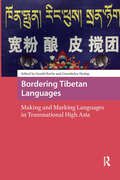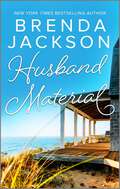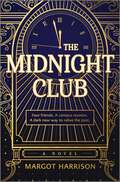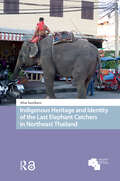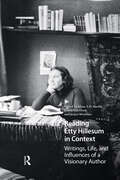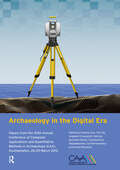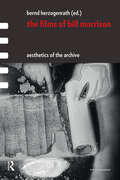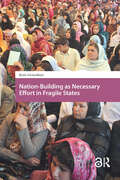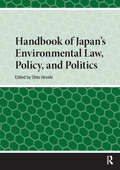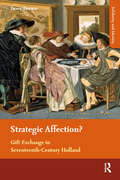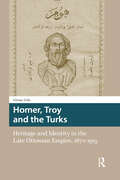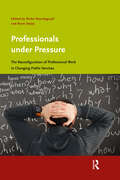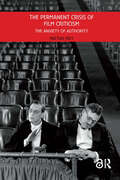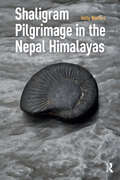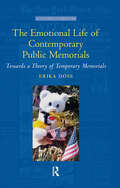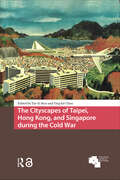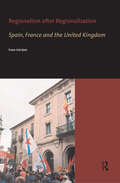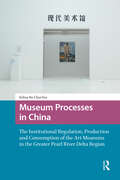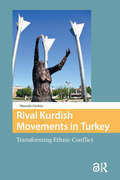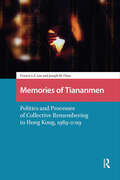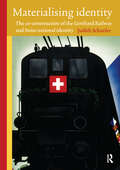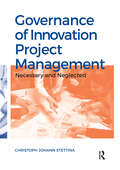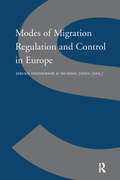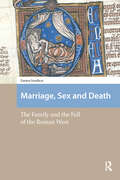- Table View
- List View
Bordering Tibetan Languages: Making and Marking Languages in Transnational High Asia (Asian Borderlands)
by Gerald Roche Gwendolyn HyslopBordering Tibetan Languages: Making and Marking Languages in Transnational High Asia examines the complex interactions between state, ethnic, and linguistic borders in the Himalayas. These case studies from Bhutan, China, India, and Nepal show how people in the Himalayas talk borders into existence, and also how those borders speak to them and their identities. These ‘talking borders’ exist in a world where state borders are contested, and which is being irrevocably transformed by rapid social and economic change. This book offers a new perspective on this dynamic region by centring language, and in doing so, also offers new ways of thinking about how borders and language influence each other.
Husband Material: A Passionate Contemporary Romance (A Summer for Scandal)
by Brenda JacksonA renowned Hollywood director will fight for the love of his life in this classic, must-read novel from New York Times bestselling author Brenda Jackson!Husband MaterialMatthew Birmingham is used to getting what he wants…and what he wants his ex-wife. When she returns to their Hamptons estate for the summer, he vows to win her back. But Carmen Akins is hiding a tragic secret from their past that will put their reconciliation to the ultimate test.
The Midnight Club
by Margot HarrisonA twisty, nostalgic, emotionally thrilling novel about a group of estranged college friends who experiment with a secret substance that allows them to re-live their memories—and the fallout when they uncover startling truths about a dark event from their past&“A strange, riveting, brilliant fable. Like a fever-dream of Donna Tartt&’s The Secret History.&” —LEV GROSSMAN&“How could you leave the past undisturbed when it was hiding parts of you from yourself?&”It&’s been twenty-five years since The Midnight Club last convened. A tight-knit group of college friends bonded by late nights at the campus literary magazine, they&’re also bonded by something darker: the death of their brilliant friend Jennet junior year. But now, decades later, a mysterious invitation has pulled them back to the pine-shrouded Vermont town where it all began.As the estranged friends gather for a weeklong campus reunion, they soon learn that their host has an ulterior motive: she wants them to uncover the truth about the night Jennet died, and she&’s provided them with an extraordinary method—a secret substance that helps them not only remember but relive the past.But each one of the friends has something to hide. And the more they question each other, the deeper they dive into their own memories, the more they understand that nothing they thought they knew about their college years, and that fateful night, is true.The Midnight Club explores that innate desire to revisit our first loves, our biggest mistakes, and the gulf between who we are and who we hoped we&’d be.
Indigenous Heritage and Identity of the Last Elephant Catchers in Northeast Thailand (Asian Heritages)
by Alisa SantikarnIn 2019, when Mew Salangam passed away at 91, newspapers across Thailand described him as belonging to the last generation of elephant doctors. Mew was a member of the Kui Ajiang community in Thailand, an Indigenous group living in the Northeast known for catching elephants. Sometime beginning in the 1950s, this practice gradually came to an end., Indigenous Heritage and Identity of the Last Elephant Catchers in Northeast Thailand examines how the end of elephant catching has affected the heritage and identity of the Kui Ajiang, offering an analysis that calls for close attention to the broader currents of Thai history and the development of Thai environmental and cultural heritage policies. Furthermore, the term Authorised Environmental Discourse (AED) is introduced in tandem with Laurajane Smith's Authorised Heritage Discourse (AHD) to portray how heritage embedded in nature and culture reflects impacts of political authority and how a community responds to threats of loss and challenges to the authenticity of its traditions.
Reading Etty Hillesum in Context: Writings, Life, and Influences of a Visionary Author
by Klaas Smelik Gerrit Van Oord Jurjen WiersmaThe diaries and letters of Etty Hillesum (1914—1943) have a special place among the Jewish-Dutch testimonies of the Shoah, so much so that Etty Hillesum studies has become its own field. This book offers the most important contributions from the past fifteen years of international research into Hillesum’s work and life, studying her ethical, philosophical, spiritual, and literary existential search.
Archaeology in the Digital Era: Papers from the 40th Annual Conference of Computer Applications and Quantitative Methods in Archaeology (CAA), Southampton, 26-29 March 2012 (Computer Applications and Quantitative Methods in Archaeology)
by David Wheatley Patricia Murrieta-Flores Iza Romanowska Graeme Earl Tim Sly Angeliki Chrysanthi Constantinos PapadopoulosCAA is the foremost conference on digital archaeology, and this volume offers a comprehensive and up-to date reference to the state of the art. This volume contains a selection of the best papers presented at the 40th Annual Conference of Computer Applications and Quantitative Methods in Archaeology (CAA), held in Southampton from 26 to 29 March 2012. The papers, all written and peer-reviewed by experts in the field of digital archaeology, explore a multitude of topics to showcase ground-breaking technologies and best practice from various archaeological and informatics disciplines, with a variety of case studies from all over the world.<
The Films of Bill Morrison: Aesthetics of the Archive (Framing Film)
by Bernd HerzogenrathAvant-garde filmmaker Bill Morrison has been making films that combine archival footage and contemporary music for decades, and he has recently begun to receive substantial recognition: he was the subject of a retrospective at the Museum of Modern Art, and his 2002 film Decasia was selected for the National Film Registry by the Library of Congress. This is the first book-length study of Morrison's work, covering the whole of his career. It gathers specialists throughout film studies to explore Morrison's aesthetics of the archive-his creative play with archival footage and his focus on the materiality of the medium of film.
Nation-Building as Necessary Effort in Fragile States
by René GrotenhuisPolicies intended to bring stability to fragile states tend to focus almost exclusively on building institutions and systems to get governance right. Simply building the state is often seen as sufficient for making it stable and legitimate. But policies like these, René Grotenhuis shows in this book, ignore the question of what makes people belong to a nation-state, arguing that issues of identity, culture, and religion are crucial to creating the sense of belonging and social cohesion that a stable nation-state requires.
Handbook of Japan’s Environmental Law, Policy and Politics (Handbooks on Japanese Studies)
by Ohta HiroshiThis handbook offers an exposition of the contemporary status of Japan's environmental law, policy, and politics. The compass of ecological quandaries explored within this tome is expansive, encompassing issues pertinent to both natural and synthetic ecosystems, natural resources, and inorganic materials. Each chapter's temporal framework corresponds to the postwar period, following the enactment of environmental statutes and the initiation of administrative institutionalization, situated approximately in the early 1970s. The central inquiry addressed in this compendium pertains to the extent to which prevailing environmental statutes and policies have contributed to the enhancement or conservation of Japan's natural and synthetic ecosystems, as well as the resilience of its natural resources. The authors within this volume undertake an analysis to discern the causal factors behind the quandaries by ascribing them to the existence or absence of enforceable regulations, public involvement in policy formulation processes, bureaucratic fragmentation, pioneering regulatory measures, institutional obstacles, regulatory co-optation, rational cost-effective methodologies, scientific understanding, scientific communities, ecological commerce, environmental non-governmental organizations (NGOs), and holistic ecological plans and programs. Moreover, pertinent sections raise an inquiry concerning Japan's ecological diplomacy, inquiring whether Japan serves as a leader, bystander, or obstructionist.
Strategic Affection?: Gift Exchange in Seventeenth-Century Holland (Solidarity and Identity)
by Irma ThoenGifts, from objects to hospitality and from poems to support, are a means of establishing and maintaining social ties. This study focuses on the nature of seventeenth- century Dutch social relations through the exchange of gifts by a wide range of individuals, from schoolmaster and artisan to poet and regent. Their gift-exchange behaviour is compared to contemporary gift exchange to show that both strategy and affection are necessary elements of social relations at any given time, and that what changes most is not the system but the discourse of exchange.
Homer, Troy and the Turks: Heritage and Identity in the Late Ottoman Empire, 1870-1915 (Heritage and Memory Studies)
by Günay UsluHomer's stories of Troy are part of the foundations of Western culture. What's less well known is that they also inspired Ottoman-Turkish cultural traditions. Yet even with all the historical and archaeological research into Homer and Troy, most scholars today rely heavily on Western sources, giving Ottoman work in the field short shrift. This book helps right that balance, exploring Ottoman-Turkish involvement and interest in the subject between 1870, when Heinrich Schliemann began his excavations in search of Troy on Ottoman soil, and the battle of Gallipoli in 1915, which gave the Turks their own version of the heroic epic of Troy.
Professionals under Pressure: The Reconfiguration of Professional Work in Changing Public Services (Care & Welfare)
by Bram Steijn Mirko NoordegraafOver the past decade, public services have come under increasing pressure to perform like private-sector organisations. This study demonstrates that professionals have much leeway in coping with changes caused by IT developments, distributed knowledge and more demanding public which have all created new pressures on public services. The authors conclude that rather than demanding more autonomy and space, public service professionals need renewed and workable professional standards.
Would I Have Sexted Back in the 80s?: A Modern Guide to Parenting Digital Teens, Derived from Lessons of the Past
by Allison OchsSince smartphones have made their debut, a clear sense of frustration can be felt by parents around the globe. Be it social media, bullying, porn, gaming, tv-series or sexting; parents are overwhelmed or insecure as they struggle to keep up with the yet newest app. Drawing on stories from her past, Allison Ochs reminds us of what it was like to be a teen. She makes you smile while making fun of her teen self. Her answers to today's problems are realistic ways to approach your teens who are dealing with the same emotions we had, however, now with their ever-present digital devices in hand. The simplicity of what she suggests will enlighten you as she gently nudges you to think about how you're dealing with the your teens online world.
The Permanent Crisis of Film Criticism: The Anxiety of Authority (Film Theory in Media History)
by Mattias FreyFilm criticism is in crisis. Dwelling on the many film journalists made redundant at newspapers, magazines, and other 'old media' in past years, commentators have voiced existential questions about the purpose and worth of the profession in the age of WordPress blogospheres and proclaimed the 'death of the critic'. Bemoaning the current anarchy of internet amateurs and the lack of authoritative critics, many journalists and academics claim that in the digital age, cultural commentary has become dumbed down and fragmented into niche markets. Mattias Freu, arguing against these claims, examines the history of film critical discourse in France, Germany, the United Kingdom, and the United States. He demonstrates that since its origins, film criticism has always found itself in crisis: the need to show critical authority and the anxieties over challenges to that authority have been longstanding concerns.
Shaligram Pilgrimage in the Nepal Himalayas
by Holly WaltersFor roughly two thousand years, the veneration of sacred fossil ammonites, called Shaligrams, has been an important part of Hindu and Buddhist ritual practice throughout South Asia and among the global Diaspora. Originating from a single remote region of Himalayan Nepal, called Mustang, Shaligrams are all at once fossils, divine beings, and intimate kin with families and worshippers. Through their lives, movements, and materiality, Shaligrams then reveal fascinating new dimensions of religious practice, pilgrimage, and politics. But as social, environmental, and national conflicts in the politically-contentious region of Mustang continue to escalate, the geologic, mythic, and religious movements of Shaligrams have come to act as parallels to the mobility of people through both space and time. Shaligram mobility therefore traverses through multiple social worlds, multiple religions, and multiple nations revealing Shaligram practitioners as a distinct, alternative, community struggling for a place in a world on the edge.
The Emotional Life of Contemporary Public Memorials: Towards a Theory of Temporary Memorials (Meertens ethnology cahier)
by Erika DossFrom the commemoration of September 11to the Holocaust memorial in Berlin, recent decades have witnessed a substantial increase in the number of new publicmemorials built in both Europe and theUnited States. This volume considers thecontemporary explosion of public commemoration in terms of changed cultural and social practices of mourning, memory, and public feeling. Positingmemorials as the physical and visual embodiment of our affective responses to loss, Erika Doss focuses especially on the memorial ephemera of flowers, candles, balloons, and cards placed at sites of tragic death in order to better comprehend how grief is mediated in contemporary commemorative cultures.
The Cityscapes of Taipei, Hong Kong, and Singapore during the Cold War (Asian Cities)
by Ying-Kit Chan Tze-Ki HonThis volume presents a comparative analysis of three key cities—Hong Kong, Singapore, and Taipei—during the Cold War. Strategically positioned within international trade networks, these cities also served as critical nodes for both regional conflicts and cooperation. The comparison primarily focuses on their urban landscapes, drawing on the memories embedded in their collective memoryscapes, the imagery presented in their filmscapes, and the perceptions of their inhabitants, as reflected in fiction and films that portrayed urban life and the experiences of ordinary people. The Cityscapes of Taipei, Hong Kong, and Singapore during the Cold War explores both the shared characteristics of these cities as frontiers in the bipolar global system (divided between Communism and the Free World) and their distinctive features as unique spaces shaped by their own meanings and opportunities.
Regionalism after Regionalisation: Spain, France and the United Kingdom (AUP Dissertation Series)
by Frans SchrijverThroughout Europe regionalist movements claim more autonomy for their region, pointing at cultural and historical distinctiveness and the demands of their populations. In some places violence is used to put pressure on the state, and in many states in Europe and elsewhere the issue of regional minorities figures prominently on political agendas. Over the last few decades many states have introduced regional governments and parliaments, often as an answer to regionalist demands with a view of making regionalist movements redundant and satisfying most of their supporters. Others have warned that this was a step towards fragmentation and even the break-up of nation states.Regionalism after Regionalisation presents a response to this debate. Concentrating on three countries, Spain, France and the United Kingdom, and three regional case studies of Galicia, Brittany and Wales, this book offers an analysis of the development of political regionalism after regionalisation. It examines the ways in which regionalisation influences the institutionalisation of a region and the establishment of regional identities. It explains how the introduction of regional governments and elections alters the conditions in which claims for a regionalist project are put forward and in which ways it effects public demands for regional autonomy. This study analyses whether regionalisation is accepted as a sufficient answer to those demanding political and cultural autonomy, and how political actors from regionalist and mainstream political parties deal with new regional political institutions as opportunities to mobilise support.
Museum Processes in China: The Institutional Regulation, Production and Consumption of the Art Museums in the Greater Pearl River Delta Region (Asian Visual Cultures)
by Chui-fun Selina HoThis book challenges the museum enterprise in China as a state monopoly and considers it as a new cultural agency that has emerged in the early twenty-first century. Following a constructive and multi-perspectival approach, it discusses the roles of political and cultural-economic agents, museum intermediaries, and museum publics in the interlinked processes of regulation, cultural production and consumption, and the issues of identity and representation faced by the art museums in the Greater Pearl River Delta Region. It broadly traces the art museum from its origin as a tool of nationalism and adoption as a vehicle of modernization in both nationalist and early communist periods, until its role in the present, as it reflects the contested and alternative representations, diverse publics, and fissured identities of the post-economic reform period of China.
Rival Kurdish Movements in Turkey: Transforming Ethnic Conflict (Protest and Social Movements)
by Mustafa GürbüzThis book explores the conditions that encourage non-violent civic engagement in emerging civil societies. Gürbüz examines the radical transformations over the past decade in the politics of Turkey's Kurdish minority. On the eve of the new millennium, the Turkish state was still openly denying the existence of Kurds, calling them mountain Turks, and Kurdish populated cities were ruled under martial law. Kurdish politics in Turkey was dominated by a revolutionary movement, the PKK, which engaged in violent clashes with the state. Less than a decade later, the PKK's rebellion had all but ended, and Kurdish political and civic movements of numerous stripes had emerged. The Turkish state even introduced an official Kurdish-language TV channel. How did this rapid change occur? Gürbüz proposes that contending social movements has transformed the politics of the region, ushering in an era of post-conflict political and cultural competition.
Memories of Tiananmen: Politics and Processes of Collective Remembering in Hong Kong, 1989-2019 (China: From Revolution to Reform)
by Francis Lee Joseph Man ChanMemories of Tiananmen: Politics and Processes of Collective Remembering in Hong Kong, 1989-2019 analyzes how collective memory regarding the 1989 Beijing student movement and the Tiananmen crackdown was produced, contested, sustained, and transformed in Hong Kong between 1989 and 2019. Drawing on data gathered through multiple sources such as news reports, digital media content, on-site vigil surveys, population surveys, and in-depth interviews with activists, rally participants, and other stakeholders, it identifies six key processes in the dynamics of social remembering: memory formation, memory mobilization, memory institutionalization, intergenerational transfer, memory repair, and memory balkanization. The book demonstrates how a socially dominant collective memory, even one the state finds politically irritable, can be generated and maintained through constant negotiation and efforts by a wide range of actors. While Memories of Tiananmen mainly focuses on the interplay between political changes and the Tiananmen commemoration in the historical period within which the society enjoyed a significant degree of civil liberties, it also discusses how the trajectory of the collective memory may take a drastic turn as Hong Kong’s autonomy is abridged. The book promises to be a key reference for anyone interested in collective memory studies, social movement research, political communication, and China and Hong Kong studies.
Materialising identity: The co-construction of the Gotthard Railway and Swiss national identity (Technology and European History Series)
by Judith SchuelerSince its opening in 1882, the Gotthard Railway with its 15-kilometer long tunnel under the Gotthard Mountains, provides a crucial international link through the Swiss Alps, between North-Western Europe and Italy. In contrast to many other railway lines, its symbolic meaning has never sunk into oblivion. In Swiss society today, references to the Gotthard myth are multifaceted and omnipresent. Not only do they evoke images of a technological railway project, they also allude to Swiss history, alpine nature and national identity. Reading this book assists in understanding the old and contemporary discussions about the future of the Gotthard Railway, the regions in which it lies and the Swiss national identity.Curiosity-driven, this research combines viewpoints from the history of technology, cultural studies and cultural geography to grasp the intensity of the Gotthard as a national Swiss image. Whereas the relationship between the Gotthard Mountains and the Swiss national identity has received ample scholarly attention, the role of the Gotthard Railway remains largely unexplored.,To illustrate to what extent historical actors co-constructed the railway and Swiss identity, the empirical chapters start with an analysis of an engineering discussion about tunneling methods. Hereafter, the book examines the reactions in Switzerland to the inauguration of the railway line. Subsequently, it describes the appreciation of the railway line portrayed in travel guides of the belle époque. The last chapter captures the glory days of the Gotthard myth, before and during the Second World War, with a focus on the novels and plays, in which the Gotthard Tunnel construction occurs. This historical overview offers insight into the multiple roles that technology plays in the construction of a sense of national identity as well as illustrating how identity has an effect on the appropriation of a technological railway project.
Governance of Innovation Project Management: Necessary and Neglected
by Christoph Johann StettinaThe study is motivated by the aspiration to understand project governance in organizations pursuing the development of new products and services across multiple knowledge worker teams. In particular, the following problem statement guides the study: Is governance of innovation project management necessary or neglected? Taking the example of agile teams, illustrated here is how the advancements in team based project management approaches force us to rethink governance of innovation project management. The findings are based on eight studies. The data consists of results from a total of 53 knowledge worker teams across 44 organizations in 8 countries, viz. about 3800 minutes of recorded material enriched by four quantitative surveys and many hours of observations. The two main conclusions drawn from this study are: (1) fundamentally different approaches to governance of innovation projects are a prerequisite for a success of projects developing new products and services, and (2) governance, particularly in heavily top-down influenced fields such as public administration, will benefit from advancements in agile project management methods.
Modes of Migration Regulation and Control in Europe (IMISCOE Reports)
by Jeroen Doomernik Michael JandlIn Europe immigration is a politically burning issue, especially when it comes to the arrival of asylum seekers and illegal labour migrants. Governments want to keep them under control in order to limit their numbers. Yet, traditionally there were strong differences between European states in the extent to which they sought to do so and the instruments employed to that end. Currently, the contours become visible of a common approach towards – notably irregular – migration. This becomes clear from the country studies comprising this volume.
Marriage, Sex and Death: The Family and the Fall of the Roman West (Social Worlds of Late Antiquity and the Early Middle Ages)
by Emma SouthonBy the end of the fifth century, with the structural collapse of the Roman Empire in the west, Western Europe had fallen into the so-called Dark Ages. With the power of Rome removed, the Catholic Church stepped in to fill the void. Its political rise, alongside that of the Germanic kingdoms, led to dramatic changes in law, politics, power, and culture. Against the backdrop of that upheaval, the family became a vitally important area of focus for cultural struggles related to morality, law, and tradition. This book explores those battles in order to demonstrate, through the family, the intersections between Roman and Christian legal culture, thought, and political power.
